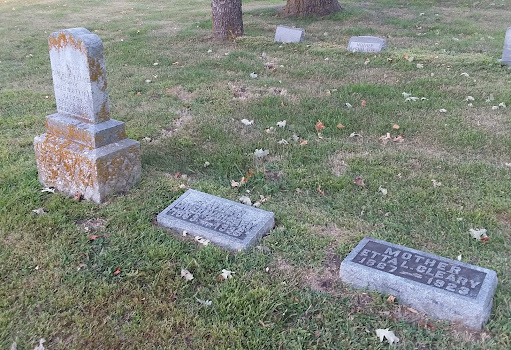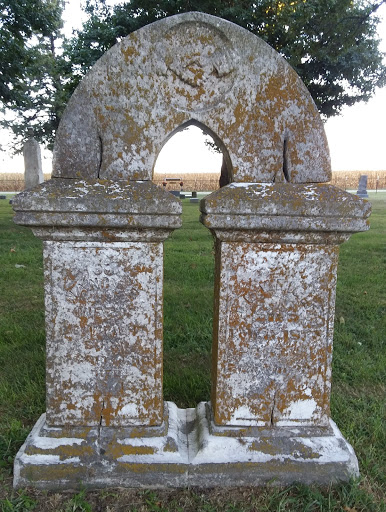The community of Bancroft was in shock. Their marshal was dead—killed in the line of duty. Strong and vital, in his early 40’s, William Gallion was well liked and respected in the community. He and his family had moved to Portland Township in 1865 when he was just a boy and he had grown up working on the farm. After his father passed, the family moved to Bancroft and he worked digging wells until he was elected city marshal and water superintendent in 1895.
His duties as a small-town marshal were pretty routine—investigating complaints, checking out strangers who wandered into town, escorting an occasional imbiber home when they were a little tipsy. So how did he end up dead on October 9, 1896?
BANK ROBBERY AND MURDER
Two days earlier the bank in Sherburne, Minnesota, had been robbed by two men using the names J. D. Sair and Fred Pratt. During the robbery the assistant cashier, George Thorburn, and a customer, Olof Oestern, had been killed. The robbers had escaped by jumping thru a back window and riding their bicycles out of town, headed toward the Iowa line. The two separated when just a few miles out of town to avoid detection. Word soon spread and lawmen on both sides of the border were warned to be on the lookout for strangers matching their descriptions. The fugitive known as J. D. Sair spent the night at Swan Lake and then head northeast the next morning being pursued as far as Swea City. Cutting into Seneca Township, he again headed northeast. By this time Marshal Gallion was on the trail and followed him to a farm site several miles east of Elmore, Minnesota. Believing that the suspect had bedded down for the night, Gallion returned to Elmore.
The next morning Gallion joined forces with Deputy Sheriff E. E. Ward of Fairmont, E. D. Fuller of Bancroft, M. E. Coffey of Sherburne, and Sandy McDonald, sheriff of Blue Earth. Gallion directed them to the home of Ole Munson. Driving their teams into the yard, Ward jumped out of the buggy driven by Marshal Gallion, approached the house and knocked on the door. Mrs. Munson came out. He told her why he was there and described the suspect, asking if she had seen anyone of that description riding a bike. She made no reply but using her thumb, pointed to the back door.
At that moment, the door opened slightly and a .38 caliber revolver appeared and began firing, first at Fuller, then at McDonald and finally at Ward who dodged to one side. Ward moved to a window three feet from the door and began firing at the fugitive. Fuller, who was driving the other buggy, whipped the team to action and called out to the others to look out. He drove a short distance from the house with Gallion’s team following behind. He hitched his horses to a fence and then turned to see Gallion slightly slumped in his seat. Realizing something was wrong, he rushed to him, eased Gallion out of the buggy and on to the ground. As he opened his coat, he discovered Gallion had been shot near the heart and he expired shortly thereafter without a struggle. Fuller laid him on a robe and covered his body.
Back at the Munson house, the gunfight continued. Sair made a break for a small building a short distance from the residence. He mounted the bicycle he had hidden there and rode north, the posse soon in hot pursuit. Sair was an excellent bicyclist and he bobbed and weaved down the road making it difficult to get a good shot. After about four miles though, one of the men managed to shoot out his rear tire. He left the bike and sought refuge in a nearby corn field. Deputy Sheriff Ward took careful aim with his Winchester, fired and wounded the suspect. Sair continued on for a few more rods, then pulled out his own revolver, held it to his temple, and pulled the trigger. Numerous rounds were fired by the lawmen into his body to assure his demise. On his person they found $1,020.03 in cash, two loaded revolvers and a large knife. His body was taken to Elmore by Deputy Sheriff Ward.

Headline from The Republican
October 14, 1896
SUSPECT NUMBER 2
The second robbery suspect, known as Fred Pratt, was taken into custody the next day in Lake Mills. It soon became apparent that he was using an alias, but he refused to give his correct name. He did confess to being one of the robbers and did state that J. D. Sair was his brother. After separating from his brother a few miles out of Sherburne, he rode west and then followed the Des Moines river south before stopping for the night at a farmer’s house about five miles south of Estherville. After breakfast he started out again following the river until just south of Emmetsburg where he turned east and headed for Algona. Occasionally he would take refuge in a corn field to avoid meeting teams or people on horseback. He finally arrived in Algona about 9 p.m. and put up at a local hotel. The next morning, he had his bicycle repaired and then stopped at the local express office to see if the items he and his brother had shipped had arrived. Not finding the shipment there, he decided that he’d better not wait for its arrival and was soon on his was way out of town.As he left Algona, it began to rain making the roads difficult to maneuver. He ended up walking and pushing the bike much of the way. By the time he made it to Lake Mills on Saturday afternoon, October 10th, he was worn out, soaked to the skin, and gave no resistance when arrested. Officers found three loaded revolvers and two knives in his possession. Pratt told the authorities he was from Cedar Rapids and was on his way to Minneapolis. After being interrogated, he did admit to being one of the Sherburne robbers and that the suspect who killed himself was his brother. He insisted that his brother did all of the shooting and that when they planned the robbery, it was understood that there would be no shooting. Even after confessing to the crime, he refused to give his real name. The prisoner was placed under heavy guard due both to the severity of the crimes committed and threats of lynching.
The prisoner was moved to the Fairmont, Minnesota, jail and finally, on October 13th, he told the sheriff there his true name – Lewis Kellihan from Rock Rapids, Iowa. His statement was confirmed and his parents, who still resided in Rock Rapids, were notified. They identified the dead robber as J. H. (Hans) Kellihan. His parents were devastated at the news—one son dead and a second son under arrest for murder.

Headline from The Republican
October 21, 1896
Trial for Lewis Kellihan was set for March 23, 1897, in Fairmont, Minnesota. The defendant was represented by H. G. McMillen, a well-known lawyer. It is said that he represented Kellihan pro bono as Lewis had rescued McMillen’s daughter five years before from drowning. Because of the notoriety of the event, seating a jury was extremely difficult. Three pools of jurors had to be called in before the correct number of jurors was chosen.
During the trial, the defendant’s father, John Kellihan, testified that Lew had always been a good boy and had never gotten into any trouble. Around the age of 12 he had been thrown from a horse onto frozen ground and suffered a head injury. He was unconscious for two days and in bed for two weeks. Lewis had been a different person following the accident. Among other things, his decision-making skills were adversely affected as well as his comprehension of the seriousness of a situation, and his parents knew that he could easily be led into situations beyond his full understanding. During the trial he often smiled or laughed at inappropriate times and did not seem to grasp the seriousness of the proceeding. In fact, the reporter covering the trial for the Fairmont Sentinel observed, “He has certainly not been acting, but is either dull of understanding or a hardened evil doer.”
GUILTY OF MURDER IN THE 1ST DEGREE
Following the trial and deliberations, the defendant was found guilty of murder in the first degree. As a part of their verdict, the jury also made a special request for mercy for the defendant. Sentencing was set for April 12th. Despite multiple requests for clemency, Lewis Kellihan was sentenced to death by hanging on August 12th. His attorneys then petitioned the Minnesota State Board of Pardons which met in July. Kellihan’s sentence was commuted to life imprisonment in the state penitentiary. By late 1899, it was reported that Lewis was “losing his mind” and as time progressed, his mental health deteriorated until he became violently insane. He died January 28th, 1902. An autopsy disclosed a brain tumor which was thought to have caused many of his behavior problems in his last years.
GALLION'S FUNERAL

Bancroft opera house known as
Jefferson Hall
The funeral for William Gallion was held on Sunday afternoon, October 11, 1896. It was originally intended to be held in the Methodist Church, but due to the size of the expected crowd was moved to the Bancroft town hall/opera house, known as Jefferson Hall. Even with a larger room, almost half of the mourners were forced to stand outside. A life-size picture of Gallion was placed in the center of the hall, draped in black.
The Bancroft banks started a fund to assist Will’s widowed mother and to erect a suitable monument in his memory. However, I could find no evidence that such a memorial was ever constructed. After losing his life in the line of service, Marshal William Gallion lies forgotten in an unmarked grave in Portland Township Cemetery.
My thanks to Doug Nyman of the Bancroft Historical Museum for his help in locating a photo of the Bancroft opera house.
Until next time,
Jean
If you enjoyed this post, please don’t forget
to “like” and SHARE to Facebook. Not a Facebook user? Sign up with
your email address in the box on the right to have each post sent directly to
you.
Be sure to visit the KCHB Facebook page for
more interesting info about the history of Kossuth County, Iowa.
Reminder: The
posts on Kossuth County History Buff are ©2015-20 by Jean Kramer. Please
use the FB “share” feature instead of cutting/pasting.





















